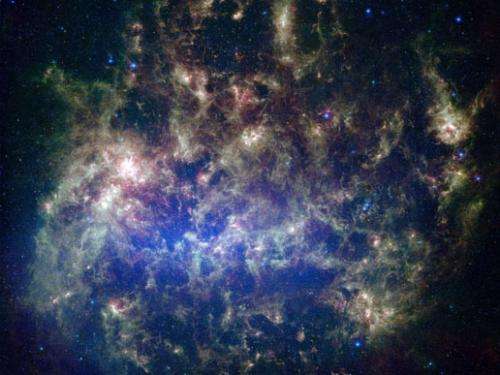Organic conundrum in Large Magellanic Cloud

(Phys.org) —A group of organic chemicals that are considered carcinogens and pollutants today on Earth, but are also thought to be the building blocks for the origins of life, may hold clues to how carbon-rich chemicals created in stars are processed and recycled in space.
Scientists have studied how polycyclic aromatic hydrocarbons (PAHs) are created in an aging population of stars in the Milky Way's satellite galaxy, the Large Magellanic Cloud. They have found that the types of PAH found in the atmospheres of these stars are much more varied than the PAHs observed in our own galaxy. The results will be presented by Dr Mikako Matsuura of UCL on Monday 23 June at the National Astronomy Meeting in Portsmouth.
"We were surprised because previous measurements of PAHs in interstellar dust in the Large Magellanic Cloud were very similar to those in the Milky Way," said Matsuura. "Our studies suggest these organic molecules are processed and change their composition soon after they are ejected by dying stars to fill the matter within the galaxy. Dying stars in the neighbouring galaxy are richer in carbon than the Milky Way's stars, so are more likely to trigger these wide varieties of organic compounds."
Matsuura and an international team observed 24 carefully selected stars with the Spitzer Space Telescope and analysed the light to find features linked to PAHs. Stars are powered by nuclear fusion in their cores, converting hydrogen to helium. Towards the end of their life, low-mass stars like the Sun consume all their hydrogen in the stellar core and start to convert helium to oxygen and carbon. Eventually, they run out of fuel and expel their outer layers, creating a nebula around a central white dwarf. The gas and molecules from this nebula are mixed over time into the Interstellar Medium. The team focused their study on stars that appeared to be in the process of fusing carbon.
"We think that, as the central star evolves, the increasingly energetic radiation effects the compositions of the PAHs, leading to more varieties. However, once the PAHs are mixed into the Interstellar medium, this variability decreases," said Matsuura. "One possibility for this contrast is that ultraviolet radiation might change the profiles of the PAHs. Another is that PAHs are re-processed further in the Interstellar Medium, changing their composition."
Provided by Royal Astronomical Society



















